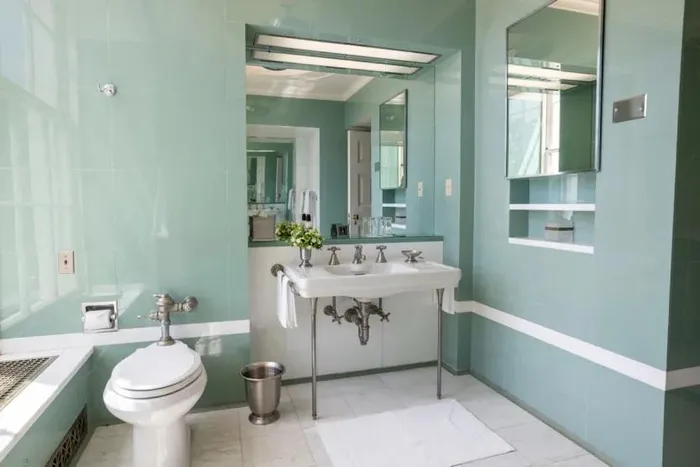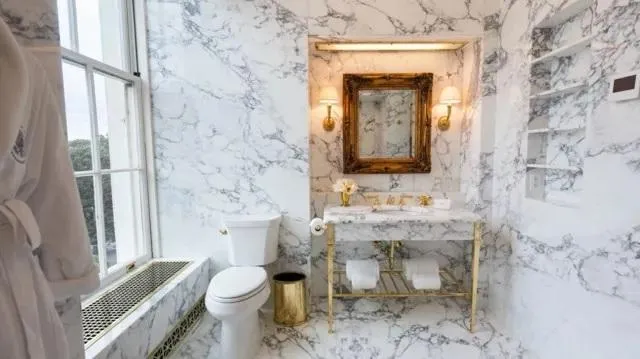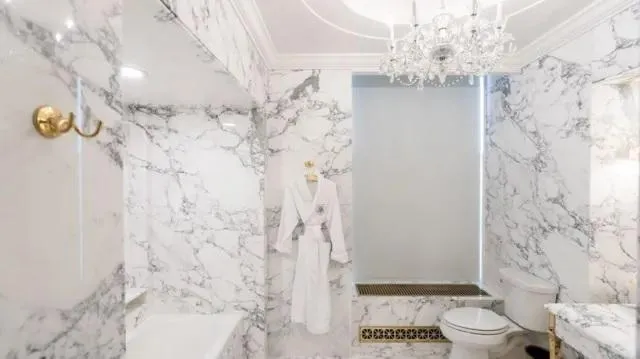It's a whole lotta marble! - Designers on Trump’s Lincoln Bathroom

The new look Lincoln Bathroom in the White House.
Image: Truth Social
Rachel Kurzius
President Donald Trump announced Friday that he had renovated the Lincoln Bathroom. “It was renovated in the 1940s in an art deco green tile style, which was totally inappropriate for the Lincoln Era,” he wrote on Truth Social, alongside two dozen photos. “I did it in black and white polished Statuary marble. This was very appropriate for the time of Abraham Lincoln and, in fact, could be the marble that was originally there!”
Indeed, marble makes up the entire room - walls, floor, counters, tub - punctuated only by gold fixtures, a gold trash can and a gold towel rack.
The reveal was startling, in part because of the total transformation and dramatic use of marble and because it comes on the heels of the demolition of the entire East Wing to make way for Trump’s planned ballroom. Any changes to the White House tend to attract strong reactions, but designers and experts interviewed by The Post had a more measured take on the bathroom renovation. While many had quibbles over the aesthetics (so much marble!) and accuracy of Trump’s claim to Lincoln-era fealty, they didn’t oppose the idea of overhauling the bathroom - though they might have done it differently.
“It feels like a modern-day interpretation of a traditional hotel bathroom but without the architectural soul,” says Paul Wiseman, founder and president of San Francisco-based interior design firm the Wiseman Group, over email.

The original Lincoln Bathroom fitted out by the Truman's in the 1940s.
Image: Truth Social
Annie Downing, of Annie Downing Interiors in Austin, similarly compared the results to what one might find in a hotel or a design showroom. (The plush robe with the presidential seal on display in the photos certainly doesn’t help fight the hotel room allegations.) “It’s very cold and overly polished and sort of lacking in warmth and personality, and it just has an excessive amount of marble,” she says. “It has like zero sense of history.” (Downing has her own history with the White House. Before her current career, Downing worked in the West Wing under President Bill Clinton.)
Still, interior designer Liz Potarazu of the Potomac, Maryland-based LP & Co., sees the new version as “an improvement on what was there before.”
“The old style was outdated and not in keeping with the historical nature of the White House,” she says over email, adding, “Marble is a timeless material, but perhaps it was a bit overused in this latest iteration.”

The scene today - all overlayed in white marble and gold
Image: Truth Social
The Lincoln Bathroom, part of the Executive Residence of the White House, shares a name with the more famous adjacent Lincoln Bedroom, dubbed in 1945 when President Harry S. Truman placed Lincoln-era furniture there as part of a broader renovation, according to the White House Historical Association. (Lincoln used the space as an office, not a bedchamber.) Because the room is part of the private residence, it sits outside the purview of the Committee for the Preservation of the White House, per the historical association.
The bathroom uses statuary marble, a luxurious material from Italy known for its bright white color, which contrasts with its darker veining. “That marble would have been very unusual in bathrooms at this time [of Lincoln],” says Alison K. Hoagland, author of “The Bathroom: A Social History of Cleanliness and the Body” and previously the senior historian of the Historic American Buildings Survey of the National Park Service. “The bathroom fixtures would have been encased in wood because they were looking for more of a domestic, friendly, warm look in a bathroom.”
“One important thing to realize is that our bathrooms today are very based around the idea of sanitation, and that sanitation involves clean, hard surfaces,” Hoagland says. “They did not have that mode of thinking in the 1860s, so the marble walls would have been shocking.”
Diana Lombard, of Diana Lombard Interiors in Fairfax Station, Virginia, notes over email that “white marble was used for other applications during that era, so is not a totally ostentatious choice on Trump’s part.” But she also would have liked to see the material used “sparingly and strategically, instead of cladding every surface in it.”
“Integrating the marble with other natural materials that were more common during the 1860s would have better honored the period’s architectural integrity and created a more rich, layered and elegant space,” she says.
(Lombard is also worried about the functionality of the material: “Polished marble floors become very slippery when wet, and are not a practical choice for outside of a shower.”)

Cold and clinical and hotel like. Critics believe sometimes less is more.
Image: Truth Social
Wiseman would have preferred to see “more detailing in the stonework,” he says. “Instead, we see large slabs simply assembled together. It’s a missed opportunity.”
Christopher Boutlier of Christopher Boutlier Interiors in Washington agrees. “The gold fixtures and broad marble slabs give it a generic opulence rather than a sense of place,” he writes over email. He suggests that the renovation could have better celebrated American craftsmanship by “using local stone from Pennsylvania or Vermont, finely detailed millwork, and beautifully made metalwork that shows the hand of the maker. The White House deserves design that honors its heritage through subtlety, proportion and care, not surface-level luxury.”
Regardless of how the bathroom looks, the designers agreed that it is the president’s prerogative to make changes to the private rooms of the White House, such as bathrooms.
“What I really admire about the White House is it’s such a great capsule of personal taste and change because every president’s made an imprint on the building,” says Thomas Jayne of Jayne Design Studio in New York, who has been visiting the White House since the 1980s. “It’s sort of a monument to change and taste.”
Jayne thinks the new version of the bathroom is “just fine because it represents that personal taste.”
Still, he wishes the White House had called him up to assist and really take the project to the next level. “I would say it is a very good example of a contemporary bathroom that almost all of us would be happy to have. It’s just, at the White House, we expect it to be a little more detailed or enriched.”
Indeed, the bathroom does reflect the aesthetic preferences we’ve come to associate with Donald Trump: the desire for grandiose materials, the predilection toward shiny gold over anything that might acquire a patina. This isn’t even the first time we’ve seen him decorate a bathroom with a large crystal chandelier.
And surely, after nearly a century, the bathroom probably required some serious upgrades. White House press secretary Karoline Leavitt said she was “horrified” by the existence of the old toilet. While her wording choice drew condemnation from some Democrats, especially given the ongoing government shutdown, Downing granted that “a new toilet probably was a good idea. That one, the [previously] existing toilet, looks really uncomfortable.”
Ultimately, the critiques pale in comparison with concerns about the demolition of the East Wing, which most Americans oppose. “He tore down the East Wing. We were all upset about that,” says Downing. “And now he did a bathroom and everyone’s like, ‘Okay, well, it’s just a bathroom.’”